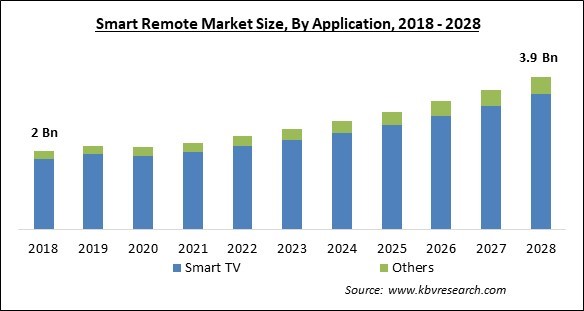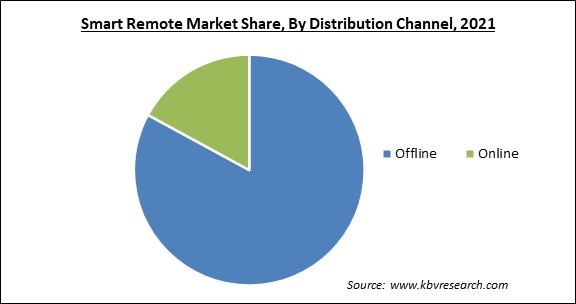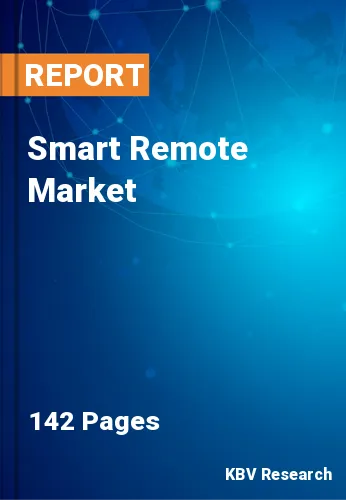The Global Smart Remote Market size is expected to reach $3.9 billion by 2028, rising at a market growth of 8.6% CAGR during the forecast period.
A smart remote is a wireless remote control that consumer devices can operate. It can connect to the home's Wi-Fi network and operate the devices. A smart remote can usually handle five or more gadgets in the house, ranging from TVs and speakers to linked devices like smart lighting and thermostats. It accomplishes the process by including a variety of infrared (IR) sensors and radios for controlling the television, as well as Wi-Fi and Bluetooth for controlling connected home devices. A smart remote may also feature an inbuilt screen that adjusts to the device consumer managing. Some smart remotes are physical devices that take up a dedicated position on the coffee table, while others are apps that take advantage of the phone's built-in features.
When consumers take the first step toward simplifying control over the smart home by reducing the remote collection from several to one, they have already taken significant steps toward a more liberated future, but it is only the start. Home automation systems have the advantage of being flexible and unique to each consumer. Every home has distinct needs and wishes for the system, and it is the responsibility to make sure consumers receive a system that operates the way consumers want it to and can adjust to all of the home's and family's control demands.
The radio remote control (RF remote control) gadget transmits a range of radio signals that are used to operate distant objects. The radio remote control is utilized with electric gate openers or garage doors, automatic barrier systems, burglar alarms, and industrial automation systems as a supplement to infrared remote controllers. Bluetooth AVRCP, ZigBee (RF4CE), and Z-Wave are the standards used for RF remotes. Most remote controls utilize its own coding, sending anything from 8 to 100 pulses in fixed or rolling code, utilizing OOK or FSK modulation. Transmitters and receivers can also be universal, which means that it can work with a variety of coding. As an example, the transmitter is referred to as a universal remote control duplicator because it can duplicate current remote controls, while the receiver is referred to as a universal receiver since it can function with virtually any remote control on the market.

With high transmission rates, the COVID-19 pandemic has caused massive losses around the world. It has brought the entire world to a halt and disrupted numerous enterprises all over the planet. The smart remote control market has not been spared from the overall impact of the COVID-19 outbreak. Lockdowns have resulted in the closure of manufacturing facilities all around the world. However, the lockdown limitations are being eased to some level in order to boost the economy. Several manufacturing units and production facilities have been given permission to operate at reduced capacity. Such a feature provides a ray of optimism for the smart remote control market's expansion.
One of the most important comprehensive economic drivers for smart home market growth is the Internet of Things platform. IoT-based technology offers energy-saving features at home. For instance, as per GSMA Intelligence, overall IoT connections will reach over multiple billion. Such a factor indicates that enormous clusters of sensors, devices, and objects will interact via high-speed technologies such as 5G within a few years. The prevalence of internet of things devices is probably going to enhance the functionality of smart remote gadgets.
The rapid growth of technology and smart city initiatives is increasing the demand for smart security systems, such as PIDS (Perimeter Intrusion Detection System). Additionally, there is a strong emphasis on effective energy management technologies to ensure accurate metering and reduce waste. The technology suppliers are being invited to contribute to smart city transportation infrastructure to enable adequate monitoring and management, reduce carbon emissions, and deliver improved route planning and optimization. Many countries are currently heavily investing in technology in order to modernize the ageing infrastructure.
The growing cyber-attack on high-end connected technology is a big barrier to smart remotes. All of the linked endpoints pose a security risk to smart home technology. As intelligent technology is linked to every system and equipment in the home, hackers can acquire access to sensitive and personal data if it is not adequately secured. For instance, as per Rambus Incorporated, a chip interface technology designer, developer, and licenser, a significant amount of IoT devices are susceptible to a variety of attacks. Any smart gadgets that is operated with internet technology is always prone to external intrusion and cyber-attacks.

Based on Application, the market is segmented into Smart TV and Others. The Smart TV segment acquired the highest revenue share in the smart remote market in 2021. Smart TVs are also equipped with a smart remote that comes with sophisticated functions. Voice-controlled functions, as well as a slew of other useful features, make smart remotes indispensable. There has been increase in demand for smart TVs in developing regions, due to the enhanced picture quality of the screen.
Based on Distribution Channel, the market is segmented into Offline and Online. The Online segment garnered a significant revenue share in the smart remote market in 2021. This is due to its increasing popularity of online platforms. To achieve a new buyer base, leading smart home appliance manufacturers are partnering with online retailers. Moreover, the increase in sales of smart home appliances, primarily through company websites and other e-commerce platforms, is expected to fuel the demand for the online distribution channel.
| Report Attribute | Details |
|---|---|
| Market size value in 2021 | USD 2.2 Billion |
| Market size forecast in 2028 | USD 3.9 Billion |
| Base Year | 2021 |
| Historical Period | 2018 to 2020 |
| Forecast Period | 2022 to 2028 |
| Revenue Growth Rate | CAGR of 8.6% from 2022 to 2028 |
| Number of Pages | 142 |
| Number of Tables | 240 |
| Report coverage | Market Trends, Revenue Estimation and Forecast, Segmentation Analysis, Regional and Country Breakdown, Companies Strategic Developments, Company Profiling |
| Segments covered | Application, Distribution Channel, Region |
| Country scope | US, Canada, Mexico, Germany, UK, France, Russia, Spain, Italy, China, Japan, India, South Korea, Singapore, Malaysia, Brazil, Argentina, UAE, Saudi Arabia, South Africa, Nigeria |
| Growth Drivers |
|
| Restraints |
|
Based on Regions, the market is segmented into North America, Europe, Asia Pacific, and Latin America, Middle East & Africa. LAMEA region garnered a significant revenue share in the smart remote market in 2021. It can be attributed to the region's rapid adoption of smart home appliances. The region is experiencing a drastic rising demand for smart appliances as a result of rising consumer interest in Internet of Things (IoT) technologies, as well as rising expenditure on smart home appliances and other technologies that assist to manufacture a smart remote gadget.
Free Valuable Insights: Global Smart Remote Market size to reach USD 3.9 Billion by 2028
The market research report covers the analysis of key stake holders of the market. Key companies profiled in the report include Crestron Electronics, Inc., Universal Electronics Inc., LG Electronics, Inc., Toshiba Corporation, Samsung Electronics Co., Ltd., Koninklijke Philips N.V., Sony Corporation, Haier Smart Home Co., Ltd., Logitech International S.A., and Bose Corporation.
By Application
By Distribution Channel
By Geography
The global smart remote market size is expected to reach $3.9 billion by 2028.
Rise in smart city initiatives are driving the market in coming years, however, high-security risks are impeding market expansion growth of the market.
Crestron Electronics, Inc., Universal Electronics Inc., LG Electronics, Inc., Toshiba Corporation, Samsung Electronics Co., Ltd., Koninklijke Philips N.V., Sony Corporation, Haier Smart Home Co., Ltd., Logitech International S.A., and Bose Corporation.
The Offline segment acquired maximum revenue share in the Global Smart Remote Market by Distribution Channel in 2021, thereby, achieving a market value of $3.14 billion by 2028.
The expected CAGR of the smart remote market is 8.6% from 2022 to 2028.
The Asia Pacific market dominated the Global Smart Remote Market by Region in 2021, and would continue to be a dominant market till 2028.
Our team of dedicated experts can provide you with attractive expansion opportunities for your business.

